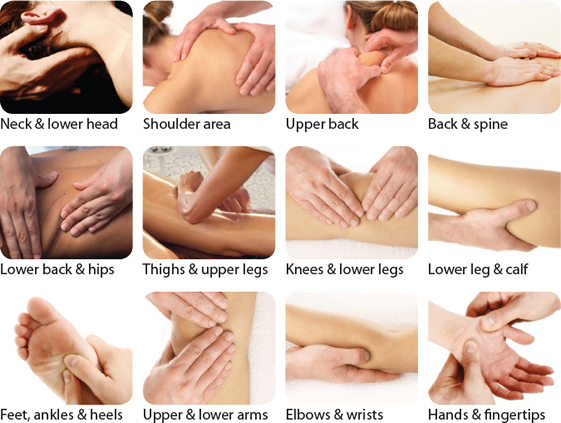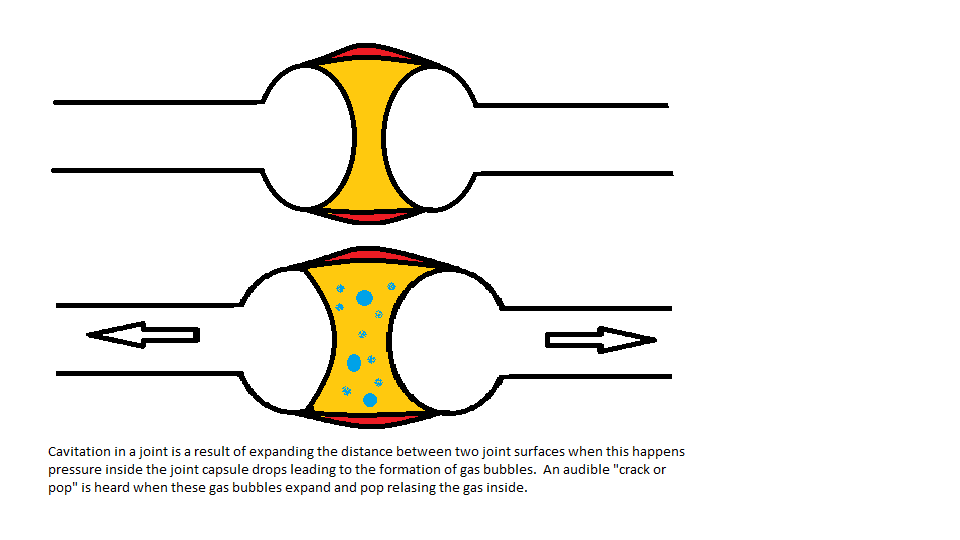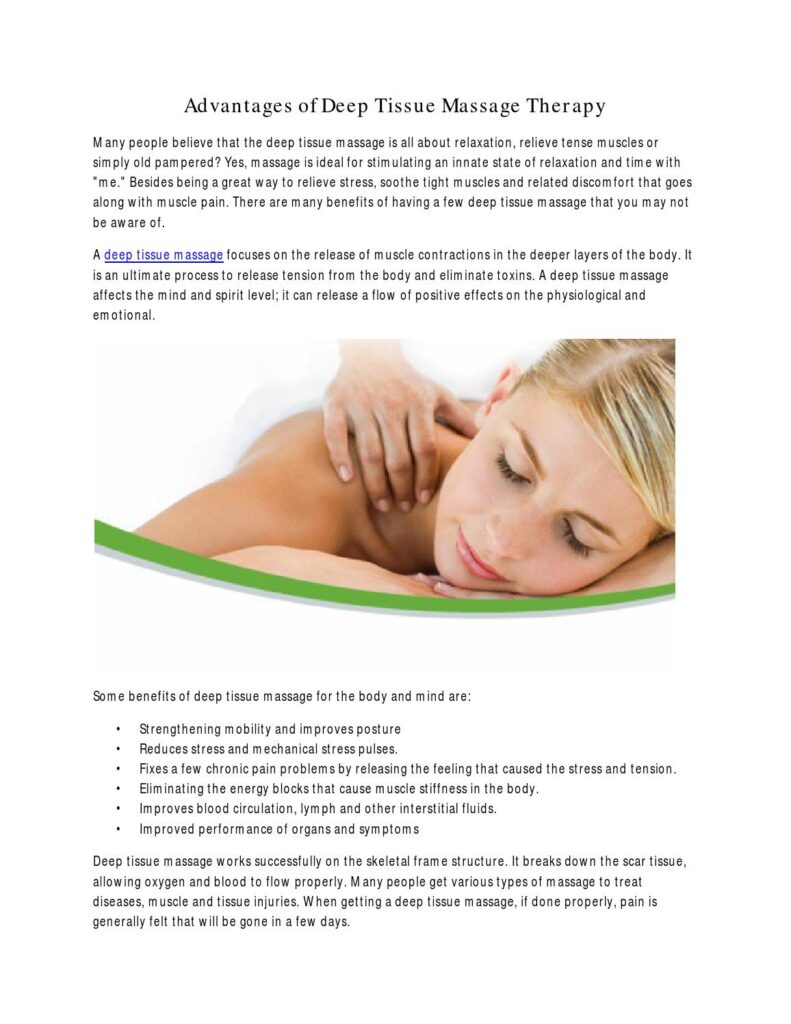If you’re looking for a holistic approach to improve your overall well-being, look no further than the health benefits of deep tissue massage. This therapeutic technique goes beyond mere relaxation, targeting the deeper layers of muscles and connective tissues to release chronic tension and restore balance to your body. By promoting improved circulation, reducing inflammation, and alleviating chronic pain, deep tissue massage offers a multitude of benefits that are sure to leave you feeling rejuvenated and revitalized. So, why not indulge in a session of deep tissue massage and experience the transformative effects it can have on your health and wellness?

This image is property of pixabay.com.
Overview of Deep Tissue Massage
Deep tissue massage is a therapeutic massage technique that focuses on reaching deep layers of muscles and connective tissues within the body. It involves applying firm pressure and slow strokes to target specific areas of tension and pain. This type of massage aims to alleviate chronic pain, reduce inflammation, improve blood circulation, enhance muscle recovery, increase range of motion and flexibility, treat sports injuries, boost immune system function, alleviate stress and anxiety, manage chronic conditions, and prevent future injuries.
Definition of Deep Tissue Massage
Deep tissue massage is a massage technique that specifically targets deep muscles and connective tissues to relieve chronic pain and promote overall wellness. It involves applying sustained pressure using the hands, fingers, elbows, or forearms to reach underlying layers of muscles. Deep tissue massage differs from traditional Swedish massage as it focuses on reaching the deeper tissues rather than just the surface muscles.
How Deep Tissue Massage Works
Deep tissue massage works by applying targeted pressure and strokes to release tension and promote healing. The therapist will use their hands, fingers, elbows, or forearms to apply varying degrees of pressure along the muscle fibers. This pressure helps to break up adhesions, scar tissue, and knots within the muscles, allowing for improved blood circulation and enhanced healing. By reaching deep layers of muscles and tissues, deep tissue massage can address chronic pain, promote muscle recovery, and improve overall physical well-being.
Relief from Chronic Pain and Inflammation
Targeting Deep Muscles and Tissues
One of the key benefits of deep tissue massage is its ability to target pain at its source by reaching the deep muscles and tissues. Whether you experience chronic back pain, tension headaches, or tightness in specific areas of your body, deep tissue massage can provide relief by focusing on those problem areas. By targeting the underlying causes of pain, deep tissue massage offers a more effective and long-lasting solution than traditional pain-management methods.
Reducing Inflammation and Swelling
Inflammation and swelling in muscles and tissues can contribute to chronic pain and discomfort. Deep tissue massage can help reduce inflammation by increasing blood flow to the affected areas. The increased circulation helps to flush out toxins and waste products, allowing for proper healing and reducing swelling. By alleviating inflammation, deep tissue massage not only provides relief from pain but also supports the body’s natural healing processes.

This image is property of pixabay.com.
Improved Blood Circulation
Stimulating Blood Flow
Deep tissue massage promotes improved blood circulation throughout the body. The firm pressure applied during the massage helps to dilate blood vessels, allowing for better blood flow. This increased circulation delivers fresh oxygen and nutrients to the muscles and tissues, facilitating their healing and repair processes. Improved blood circulation also promotes the removal of metabolic waste from the body, aiding in detoxification.
Reducing Hypertension and High Blood Pressure
High blood pressure, also known as hypertension, is a common health condition that can lead to serious complications. Deep tissue massage has been shown to help reduce blood pressure levels in individuals with hypertension. By promoting relaxation and improving blood flow, deep tissue massage can effectively lower blood pressure. Regular deep tissue massage sessions can be a valuable addition to a holistic approach in managing high blood pressure and promoting cardiovascular health.
Enhanced Muscle Recovery
Breaking Up Scar Tissue
When muscles are injured or undergo repetitive stress, scar tissue can develop, leading to muscle tightness and restricted movement. Deep tissue massage helps in breaking up scar tissue and adhesions, allowing for improved flexibility and range of motion. By breaking down scar tissue, deep tissue massage helps to restore normal muscle functioning and accelerate the healing process.
Reducing Muscle Tension and Soreness
Muscle tension and soreness are common issues that can result from physical activity, poor posture, or prolonged periods of inactivity. Deep tissue massage can effectively reduce muscle tension and soreness by targeting the deeper layers of muscles. The sustained pressure applied during the massage helps to release tight knots and trigger points, promoting relaxation and relieving muscle stiffness. By addressing muscle tension and soreness, deep tissue massage aids in quicker muscle recovery and enhances overall physical well-being.

This image is property of pixabay.com.
Increased Range of Motion and Flexibility
Breaking Up Adhesions and Fibrous Tissues
Deep tissue massage is highly effective in breaking up adhesions and fibrous tissues that can limit range of motion and flexibility. These adhesions often develop as a result of injury, overuse, or prolonged inactivity. By applying firm pressure, deep tissue massage helps to stretch and lengthen the muscles and connective tissues, reducing stiffness and improving mobility. The increased range of motion allows for a greater ease of movement and promotes overall flexibility.
Improving Joint Mobility
In addition to improving range of motion, deep tissue massage can also enhance joint mobility. By targeting the muscles and tissues surrounding the joints, deep tissue massage helps to alleviate tension and reduce joint stiffness. This allows for improved flexibility and freedom of movement in the joints. Whether you struggle with joint pain or simply want to enhance your athletic performance, deep tissue massage can play a key role in optimizing joint mobility.
Effective Treatment for Sports Injuries
Alleviating Strains and Sprains
Deep tissue massage is commonly used as an effective treatment for sports injuries, including strains and sprains. The targeted pressure and stretching techniques help to reduce pain and swelling, promote healing, and restore optimal function to injured muscles and tissues. Whether you’re an athlete recovering from a sports-related injury or an active individual seeking relief from a sprained ankle or strained muscle, deep tissue massage can accelerate your recovery and help you get back in the game.
Promoting Faster Healing of Tissues
Sports injuries often involve damage to muscles, tendons, ligaments, or other soft tissues. Deep tissue massage can promote faster healing of these tissues by stimulating blood circulation and improving the delivery of oxygen and nutrients to the injured area. The increased blood flow also helps to remove metabolic waste products that can hinder the healing process. With regular deep tissue massage sessions, you can support your body’s natural healing ability and speed up your recovery from sports injuries.
Boosted Immune System Function
Removing Toxins and Waste Products
The lymphatic system plays a critical role in the body’s immune response by removing toxins, waste products, and other unwanted substances. Deep tissue massage can help stimulate lymphatic flow, allowing the lymphatic system to function more efficiently. By improving lymphatic drainage, deep tissue massage helps to eliminate toxins and waste products, thus boosting immune system function. A stronger immune system can provide better protection against illnesses and promote overall well-being.
Increasing Lymphatic Flow
Deep tissue massage aids in increasing the flow of lymph, the fluid that carries waste products away from tissues. This helps to reduce swelling and fluid retention, which can occur as a result of injury or inflammation. By improving lymphatic flow, deep tissue massage supports the body’s natural healing processes and promotes a healthy immune system. Regular deep tissue massage sessions can contribute to a stronger immune system and improved overall health.
Alleviation of Stress and Anxiety
Promoting Relaxation and Mental Clarity
Deep tissue massage is not only beneficial for physical health but also for mental well-being. The slow, deliberate strokes and focused pressure of deep tissue massage can induce a deep state of relaxation and promote mental clarity. As the muscles release tension and stress, the mind follows suit, allowing you to experience a sense of calm and tranquility. This relaxation can alleviate built-up stress and anxiety, leaving you feeling refreshed and rejuvenated.
Reducing Stress Hormone Levels
Chronic stress can have detrimental effects on both physical and mental health. Deep tissue massage has been shown to reduce the levels of stress hormones, such as cortisol, in the body. By promoting relaxation and reducing muscle tension, deep tissue massage helps to counteract the effects of stress and restore balance to the body’s stress response system. Regular deep tissue massage sessions can provide a much-needed respite from the demands of daily life and contribute to long-term stress management.
Management of Chronic Conditions
Managing Fibromyalgia Symptoms
Fibromyalgia is a chronic condition characterized by widespread musculoskeletal pain, fatigue, and tender points. Deep tissue massage can be a valuable tool in managing fibromyalgia symptoms. By targeting specific areas of pain and tension, deep tissue massage can alleviate muscle soreness and stiffness associated with fibromyalgia. The increased blood circulation and improved lymphatic flow also aid in reducing inflammation and promoting relaxation. Incorporating regular deep tissue massage into a comprehensive treatment plan can provide relief and improve quality of life for individuals with fibromyalgia.
Relieving Symptoms of Arthritis
Arthritis is a chronic condition that causes joint inflammation, stiffness, and pain. Deep tissue massage can help alleviate symptoms of arthritis by reducing muscle tension and promoting joint mobility. The targeted pressure and stretching techniques used in deep tissue massage can relieve muscle stiffness and improve flexibility, making movement more comfortable for individuals with arthritis. Deep tissue massage can be particularly beneficial for those with osteoarthritis or rheumatoid arthritis, offering a non-invasive and holistic approach to managing their condition.
Prevention of Future Injuries
Strengthening Connective Tissues
Deep tissue massage not only helps in treating existing injuries but also plays a crucial role in preventing future injuries. By applying firm pressure and stretching techniques, deep tissue massage helps to strengthen the connective tissues, such as tendons and ligaments. Stronger connective tissues provide better support to the muscles and joints, reducing the risk of strains, sprains, and other injuries. Regular deep tissue massage sessions can contribute to overall musculoskeletal health and help you maintain an active lifestyle.
Improving Posture and Alignment
Poor posture and misalignment can lead to chronic pain, muscle imbalances, and increased risk of injury. Deep tissue massage can help improve posture and alignment by releasing tension in the muscles and restoring balance to the musculoskeletal system. The targeted pressure and stretching techniques used in deep tissue massage help to lengthen and relax the muscles, promoting proper alignment and posture. By addressing postural issues, deep tissue massage can reduce the likelihood of future injuries and support optimal musculoskeletal health.
In conclusion, deep tissue massage offers numerous health benefits for both the body and mind. From relieving chronic pain and inflammation to improving blood circulation and muscle recovery, the therapeutic techniques used in deep tissue massage can provide holistic and effective solutions for various conditions. Whether you’re seeking relief from chronic pain, recovering from a sports injury, managing a chronic condition, or simply looking to enhance your overall well-being, deep tissue massage can be a valuable addition to your self-care routine. By investing in regular deep tissue massage sessions, you can experience improved physical and mental health, greater flexibility and mobility, and a higher quality of life.



















